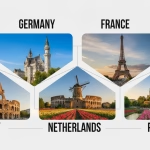Germany is a pioneer in business innovation. It blends the latest science with industrial know-how to make big leaps. This combo is key to many successful projects in the country. It helps keep Germany ahead in the business world.
- Key Takeaways
- Germany’s Investment in Research and Development (R&D)
- The Strength of Germany’s R&D Community
- Renowned Research Institutes in Germany
- Interactive Regional Networks and Clusters
- The German Mittelstand: Driving Innovation
- Sustained Innovation in Climate Neutrality
- Developing Startups: Germany’s GO! Campaign
- Germany as a Leader in Business Innovation
- The Dual Training System: An Imitated Model
- Global Integration of German Businesses
- Addressing Demographic Challenges in the Workforce
- High-Performance Infrastructure Supporting Innovation
- Support for SMEs and Startups in Financing and Innovation
- Source Links
The country’s strong support for Research and Development (R&D) plays a huge role. More and more money goes into R&D each year in Germany. This shows their strong dedication to finding new technologies. Germany even spends more on R&D than all other European countries. This makes it a key player in global business innovation.
Key Takeaways
- Germany merges cutting-edge science with business to drive innovation.
- Continued increase in R&D spending highlights Germany’s commitment to pioneering technologies.
- Germany invests more in R&D than any other European nation.
- This financial commitment underpins Germany’s role in global business innovation.
- Germany’s industrial leadership is fortified by its robust investment in new technologies.
Germany’s Investment in Research and Development (R&D)
Germany has always known the value of spending on research and development (R&D investment). They have consistently spent more to become a major EU innovation leader.
Rising R&D Spending
In the last ten years, Germany’s R&D investment has gone up a lot. By 2021, they were spending about EUR 113 billion, which is 3.1 percent of their GDP. This shows they really want to improve the country’s growth through innovation.
Government and Private Sector Contributions
What’s special about Germany’s R&D is how the government and businesses work together. More than two-thirds of the money for R&D come from companies. This teamwork helps in creating new technologies and solutions. The government also helps a lot, making a strong environment for ongoing innovation.
Impact on Global Innovation
Germany’s focused on R&D investment has made a big difference globally. Their new ideas have really shaped world innovation. This has made them important in the world and a key figure in EU innovation. This success shows the strong link between hard research work and economic growth.
The Strength of Germany’s R&D Community

Germany is a leading force in European research for its impressive R&D community. This community is large and highly skilled. It leads many scientific missions, bringing innovation to many sectors.
Largest R&D Community in Europe
Germany has 24 percent of Europe’s scientists and engineers, making it Europe’s biggest R&D community. This community is made up of hard-working professionals. They help Germany grow in science and innovation, making it a key global innovator.
International Collaboration
Germany is known for working closely with others around the world in research. Places like the Max-Planck-Gesellschaft team up on projects in 120 countries. These joint efforts make science stronger worldwide and boost Germany’s reputation as a research hot spot.
Renowned Research Institutes in Germany
Germany boasts many famous research institutes. They are essential in pushing forward innovation. These institutes also help bring academia and industry together. This strong bridge supports both big companies and smaller ones in their research and development efforts.
Fraunhofer-Gesellschaft and Leibniz-Gemeinschaft
The Fraunhofer-Gesellschaft and Leibniz-Gemeinschaft are known for their practical research. The Fraunhofer-Gesellschaft links with many companies to offer the latest technologies, aiding small and medium enterprises. The Leibniz-Gemeinschaft supports a mix of studies, giving access to high-level research resources for lesser-known companies.
Max-Planck-Gesellschaft and Helmholtz-Gemeinschaft
Organisations like the Max-Planck-Gesellschaft and Helmholtz-Gemeinschaft lead in basic research. They not only advance science but are also key to progress in innovation in Germany. Businesses rely on them for tackling tough research problems, reducing risks and boosting innovation in the country.
Role in Industry Collaboration
The bond between German research institutions and businesses stands out. It turns academic ideas into practical use, driving innovation. This connection shares knowledge and technology, making Germany a top champ in innovation globally. These partnerships also grow the economy and ensure Germany’s lead in science and tech.
Interactive Regional Networks and Clusters

Germany boosts its innovation thanks to regional innovation networks and clusters. These clusters link businesses with top technology and knowledge. This connection helps them grow and develop together.
The Germany’s innovation clusters are dynamic and supported by many schemes. For instance, the “go-cluster” initiative encourages sharing new ideas. It also helps new technologies get to the market quickly.
These hubs are vital for knowledge exchange. They keep the information flow strong between companies, research centres, and governments. This sharing speeds up innovation and gives companies a competitive edge.
They also focus on knowledge exchange. This connects different areas and fields to solve tough problems together. This approach helps Germany stay successful in innovating in business.
- Providing businesses with access to cutting-edge technology
- Fostering collaborative environments for innovation
- Supporting a seamless flow of innovative ideas through programmes like “go-cluster”
The German Mittelstand: Driving Innovation
The German Mittelstand is key to Germany’s economy. It shows a mix of stability and quick change. These firms are known for their unique skills and their drive to innovate. They are ready to face future challenges and changes.
Characteristics of Mittelstand Companies
Mittelstand companies are often run by families. This makes them focus on loyalty and the long term. They aim at specific markets, working on what they do best. Their innovation keeps them leading in quality and precision.
Role in Regional and Global Markets
These small and medium firms are big players locally and globally. Many lead the world in what they do, selling top-notch items everywhere. Their global success shows their strong innovation and their ability to meet different market needs.
Support from the Federal Ministry for Economic Affairs and Climate Action
The Federal Ministry for Economic Affairs and Climate Action helps these companies a lot. It has policies to support the Mittelstand in the long term. Through different programs, the Ministry gives them the help they need. This helps them keep innovating and staying ahead in the global market.
Sustained Innovation in Climate Neutrality

Germany’s drive towards climate neutrality is clear in its dedication to sustainable innovation. It’s aiming for a big change by using new technologies and digital tools. These help in achieving such an important goal.
Germany’s Road to Climate Neutrality
Germany leads the way with its efforts in decarbonisation. The government there has big plans to cut down on greenhouse gases. It’s driven by high energy costs to be more efficient and sustainable.
Germany wants to mix economic success with caring for the environment, all by 2030. This has also led to big tech companies investing in green technologies in the country.
Innovative Technologies for Sustainable Development
Germany is making great strides towards climate neutrality with fresh ideas. For instance, solar and wind power are key in making the air cleaner. Better ways to store energy help reduce harmful emissions as well.
Using smart tech and digital methods also helps to use energy smarter. This boosts sustainable ways of living.
Decarbonisation Efforts
Germany is cutting back on carbon use in several industries, like transport and making things. Making transport more electric and cleaning up how things are made are steps in this direction. This shows Germany’s strong role in caring for the planet.
Germany is a front runner in putting sustainable innovation to work. It ensures that steps towards caring for the Earth are also good for the economy.
Developing Startups: Germany’s GO! Campaign
The GO! startup campaign in Germany wants to boost new businesses. It gives special attention to those left out before. This includes women and migrants. They often have great business ideas but don’t have all the support they need.
Promoting Entrepreneurship Among Underrepresented Groups
The GO! campaign helps start new businesses in Germany. It makes sure everyone gets a fair chance. Programs under this campaign offer special help. This includes mentorships. They work to break down barriers and help business owners succeed.
Support Infrastructure for Startups
Germany provides a great start for new companies. Its startup system includes lots of help. Websites like www.existenzgruender.de offer everything from legal advice to how to get funds. This support is key to the GO! campaign. It helps great ideas grow into successful businesses.
This campaign is key in making Germany’s business world more exciting and welcoming. With lots of support, new businesses can do well. Germany is becoming a top spot for creative and varied business ideas.
Germany as a Leader in Business Innovation

Germany is a major player in global business innovation. It focuses on using new technologies and making smart investments in research and development. This approach has brought it to the top as a leader of industry worldwide.
German companies are at the forefront of several sectors. They lead in making solar technology more efficient and in developing new vaccines. The country is also advancing in autonomous vehicles. This progress shows Germany’s leading role in cutting-edge technology.
Germany’s success is also due to how it works together. Traditional and modern industries collaborate. This ensures that innovation happens all the time. It’s why Germany is known for its industrial excellence, creating solutions for a better, greener world.
The Dual Training System: An Imitated Model
Germany’s dual education system is a hit the world over. It mixes classroom learning with practical job skills. This way, students get both book smarts and hands-on abilities. It makes sure they’re ready for the job world.
Workforce Training and Education
The training teaches students what they need to know for jobs in the real world. It makes sure they’re good for today’s jobs and tomorrow’s too. This approach keeps workers learning, matching what they know to what jobs need.
Long-Term Success and Innovation
This system is great for making sure companies and their staff stay on top. It builds in a focus on new ideas, making sure staff help their industries move forward. It’s known for keeping up with what’s new and making sure workers are ready for modern jobs.
Global Integration of German Businesses
German companies are a key part of the world economy. They are the third biggest exporter. This means that Germany is a powerful player in global markets. Its reputation is built on high-quality products and a drive to always innovate.
Export Strength and International Market Presence
Germany’s trade presence shows its strong export abilities. When you see “Made in Germany” on a product, you know it’s top quality. This builds trust with customers worldwide. Small and medium-sized German companies are shining. They mix traditional know-how with new technology. This keeps them competitive globally.
Strong Supply Chains and Market Leadership
Strong supply chains keep Germany ahead. German companies work well in the world’s trading links. This helps goods move smoothly. Logistics and partnerships are key. They help Germany lead in global trade. This strong framework lets German firms meet global needs well.
Addressing Demographic Challenges in the Workforce
Germany is carefully watching how its population changes are affecting work. So, the country has put in place new immigration rules. These rules are made to solve workforce problems and keep a flow of skilled workers coming in.
Reformed Immigration Laws
In response to workforce challenges, new immigration laws have been introduced in Germany. They are to bring in skilled workers more easily. This change means it’s simpler for skilled workers worldwide to start their jobs in Germany.
Attracting Skilled Professionals
Germany’s efforts have paid off in attracting skilled people from different fields. The Skilled Workers Immigration Act, for example, is aimed at engineers, IT experts, healthcare workers, and more. These targeted policies are helping the country grow economically while staying ahead as an innovation hub.
By doing this, Germany is tackling the challenge of an aging population. Plus, it is boosting its economy with a steady flow of skilled workers. This smart approach to immigration is proof of Germany’s ambition to be strong in the global economy.
High-Performance Infrastructure Supporting Innovation
Germany’s innovation power thrives due to its strong infrastructure. The country focuses on both digital and traditional transport. This approach helps mix new tech with old systems, boosting growth and efficiency.
Transportation and Digital Networks
Germany is praised for its top-notch transport networks. Projects like expanding railways and updating motorways highlight its commitment. It also ensures fast internet and reliable digital services for everyone.
Government Investment in Infrastructure
The German government invests heavily in its infrastructure. It puts a lot of money into spreading fibre optics and making 5G networks available. These efforts push Germany forward into the digital age, making it more competitive worldwide.
Germany’s plan to enhance both transport and digital networks is smart. This strategy prepares the country for future challenges and successes. By focusing on these areas, it’s ready to grow further.
Support for SMEs and Startups in Financing and Innovation
Germany supports SMEs and startups a lot, especially in money and new ideas. Small businesses often have a hard time getting the money they need to grow and be creative. There’s a big network of investors and special funds to help them.
Access to Venture Capital
Venture capital is a key help for these smaller companies. In Germany, there are many chances to get money from both private investors and with government help. The country puts billions into these funds to make sure businesses can get money to be creative and expand.
Market-Driven Funding Programmes
Germany not only has venture capital but also special funds made to encourage new ideas in SMEs and startups. They have programmes like the ERP/EIF Growth Facility and ZIM. These are here to help with money, showing a strong commitment to boosting tech and the economy.











